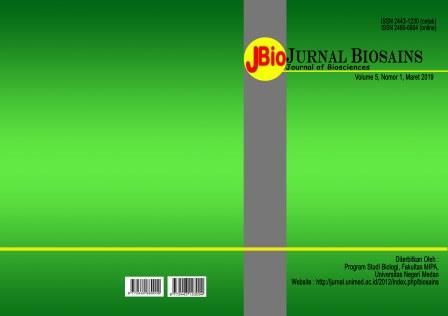PEMBUATAN BIOPESTISIDA DARI EKSTRAK DAUN SIRSAK (Annona muricata) UNTUK PENGENDALIAN HAMA ULAT API (Setothosea asigna V.Eecke) PADA TANAMAN KELAPA SAWIT (Elaeis guineensis Jacq)
DOI:
https://doi.org/10.24114/jbio.v5i1.12331Keywords:
, Setothosea asigna V.Eecke, biopestisida, daun sirsak, racun kontakAbstract
Ulat api (Setothosea asigna V.Eecke) merupakan hama pemakan daun yang terpenting di perkebunan kelapa sawit terutama di Sumatera Utara. Ulat ini dikenal sebagai ulat yang rakus yang sering menimbulkan kerugian di perkebunan kelapa sawit pada tanaman muda maupun tanaman tua. Pada perkebunan kelapa sawit, ulat pemakan daun kelapa sawit umumnya diatasi dengan menggunakan insektisida kimia sintetik yang mampu menurunkan populasi hama dengan cepat, sehingga dapat dihindari terjadinya kerusakan daun lebih lanjut. Walaupun demikian, penggunaan insektisida kimia sintetik secara kurang bijaksana telah terbukti dapat menimbulkan berbagai dampak negatif terhadap lingkungan. Tujuan penelitian ini adalah pembuatan biopestisida dari daun sirsak untuk mengendalikan hama ulat api (Setothosea asigna V.Eecke). Daun sirsak diekstrak dengan pelarut etanol 96%. Ekstrak pekat yang diperoleh diencerkan dengan akuades menjadi beberapa variasi konsentrasi yaitu 10%, 20%, 30%, 40% dan 50%. Hasil uji insektisida menunjukkan ekstrak daun sirsak 30% sudah efektif dalam mengendalikan hama ulat api. Dari hasil tersebut disimpulkan bahwa daun sirsak dapat dimanfaatkan sebagai biopestisida dalam mengendalikan hama ulat api dengan mekanisme racun kontak.Downloads
Published
Issue
Section
License
Copyright (c) 2019 Harmileni Harmileni, Gimelliya Saragih, Benny Rio Fernandez, Yunianto Yunianto

This work is licensed under a Creative Commons Attribution 4.0 International License.
For Authors Jurnal Biosains agree to the following terms:
Authors retain copyright and grant the Jurnal Biosains (JBIO) right of first publication with the work simultaneously licensed under a Creative Commons Attribution License (CC BY-SA 4.0) that allows others to share (copy and redistribute the material in any medium or format) and adapt (remix, transform, and build upon the material) the work for any purpose, even commercially with an acknowledgement of the work's authorship and initial publication in JBIO (Jurnal Biosains)
Authors are able to enter into separate, additional contractual arrangements for the non-exclusive distribution of the journal's published version of the work (e.g., post it to an institutional repository or publish it in a book), with an acknowledgement of its initial publication in JBIO (Jurnal Biosains)
Authors are permitted and encouraged to post their work online (e.g., in institutional repositories or on their website) prior to and during the submission process, as it can lead to productive exchanges, as well as earlier and greater citation of published work (See The Effect of Open Access).


